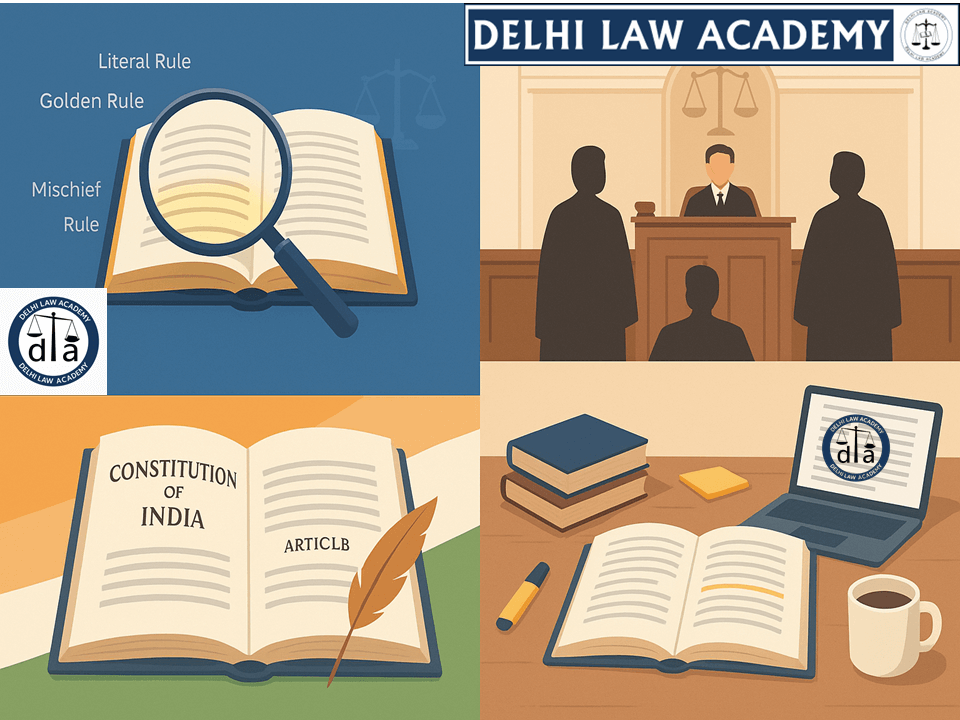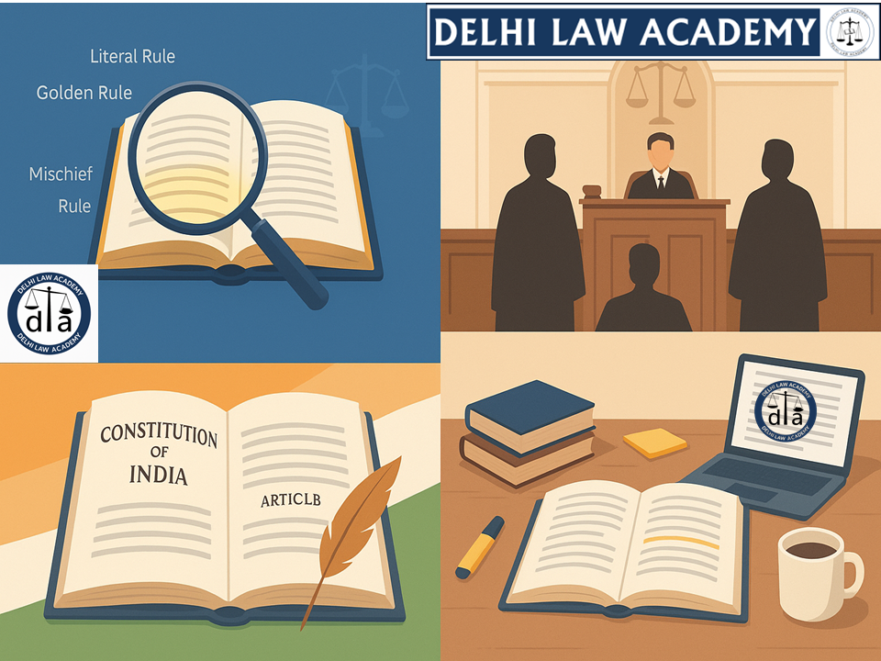
Interpretation of Statutes 📜
Delhi Law Academy Jaipur presents below for aspirants of Rajasthan Judicial Service (RJS) an insight into a very important subject of their syllabus which would help them in preparing the right way for the upcoming RJS exam in 2026.
Topic 1: Basic Sources of Statutory Interpretation 🏛️
Ans:
- The General Clauses Act 1897
- Definition clauses in various Legislations
- Article 367 of the Constitution: General Clauses Act 1897 shall apply for interpretation of this Constitution as it applies for interpretation of an Act of legislature
Section 6, General Clauses Act: Where any Act repeals any enactment: the repeal shall not affect the previous operation of that enactment or anything duly done or suffered thereunder; affect any right, obligation or liability acquired under that enactment; affect any penalty or punishment incurred for an offence committed against that enactment.
Topic 2: General Theories and Rules of Interpretation ⚖️
(a) The Function of the Court is to Interpret the Law and Not to Legislate
Padma Sundara Rao v. State of Tamil Nadu [2002 SC]: While interpreting a provision the court only interprets the law and cannot legislate it. If a provision of law is misused and abused, it is for the legislature to amend, modify or repeal it, if deemed necessary. The legislative casus omissus cannot be supplied by judicial interpretative process.
Casus omissus means “cases of omission”. Omission in a statute cannot be supplied by construction. Two principles of construction—one relating to casus omissus and the other regarding reading the statute as a whole—are well settled. Under the first principle, a casus omissus cannot be supplied by the court except in the case of clear necessity and when reason for it is found in the four corners of the statute itself.
(b) Statute Must Be Read as a Whole
A casus omissus should not be readily inferred. All parts of a statute or section must be construed together, and every clause should be interpreted in reference to the context and other clauses thereof.
(c) The Primary Rule: The Literal Rule 📖
- Manmohan Das v. Bishun Das [1967 SC]: A provision must be construed in accordance with the language used unless literal construction leads to absurdity or frustrates legislative intent.
- Padma Sundara Rao v. State of Tamil Nadu [2002 SC]: Courts cannot read anything into a statutory provision which is plain and unambiguous.
- Jugal Kishore Saraf v. Raw Cotton Co. [1955 SC]: Statutes are to be read literally. If words are precise, the court must adopt the ordinary rule of literal interpretation unless absurdity arises.
(d) The Golden Rule 🌟
If the language allows multiple interpretations, discard the literal meaning if it leads to unreasonable results and adopt a practical interpretation. Statutes should be construed with imagination to fulfill legislative purposes.
Artemiou v. Procopiou [1965 All ER]: Intention to produce an unreasonable result is not imputed if another construction is available. Courts must sometimes “do violence” to words to achieve legislative intent.
(e) Mischief Rule of Construction 🔍
Heydon’s Case [1584]: Introduced the mischief rule, more flexible than literal or golden rules.
To interpret statutes correctly, consider:
- What was the law before the Act?
- What mischief or defect existed?
- What remedy has the Act provided?
- Reason for the remedy?
New India Sugar Mills v. Commissioner of Sales Tax Bihar: Expressions in statutes should harmonize with the object of the statute and effectuate legislative intent.
Newspapers Ltd. v. State Industrial Tribunal: True import of statute requires examining enactment retrospectively, its purpose, and the evils it intended to address.
Three Fundamental Rules:
- Literal Rule: Apply plain meaning.
- Golden Rule: Ordinary sense unless absurd or inconsistent.
- Mischief Rule: Focus on policy and purpose of the enactment.
(f) Construction Ut res magis valeat quam pereat ⚖️
Better for a statute to have effect than to be void. Read laws to make them valid and operative unless language is entirely intractable.
Balram Kumawat v. Union of India
(g) Rule of Purposive Construction 🎯
Rev. Stainislaus v. State of M.P. [1977 SC]
(h) Rule of Strict Interpretation
Construction of taxing statutes:
Bedford v. Johnson: Taxes not to be extended beyond clear language; doubt resolved in favor of citizens.
Bowers v. Gloucester Corporation [1963 Q.B.]: Penal sections interpreted most favorably to citizens if doubts remain.
(i) Rule of Harmonious Construction 🤝
In conflicting provisions, interpret to give effect to both if possible.
Sultana Begum v. Prem Chand Jain 1996 SC: Courts must harmonize conflicting provisions without rendering any clause useless.
Five Principles of Harmonious Construction:
- Courts must avoid head-on clash between two sections.
- Provisions cannot defeat each other unless reconciliation is impossible.
- Conflicting provisions should, if possible, both be effective.
- Interpretation reducing a provision to “dead letter” is not harmonious.
- Harmonizing should not destroy statutory provision.
Sri Venkataramana Devaru v. State of Mysore 1958 SC: Article 26(b) must be read subject to Article 25(2)(b) to harmonize conflicting rights.
✅ This guide will help RJS aspirants master the Interpretation of Statutes for exams effectively!
📚 Further Reading for Law Aspirants
Explore more useful resources from Delhi Law Academy to strengthen your preparation:
Contact us
📍 Delhi Law Academy – Jaipur Branch
6C, Tower 2, Coaching Hub, Pratap Nagar, Jaipur – 302033
📞 Phone:
+91 9911916552
+91 8447285606
✉️ Email:
contactus@delhilawacademy.com

